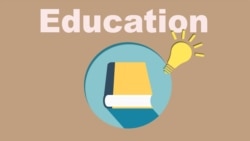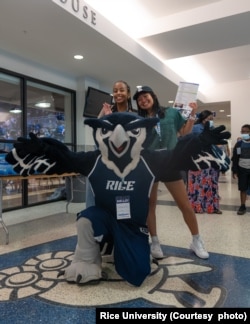Students have until the end of April to tell the universities that have accepted them if they will attend.
Most students found out if they were accepted in late March. Some students are accepted by their top choice school and immediately decide they will attend it. Others get rejections and must choose another school. Still others are placed on a waiting list and might not find out if they are accepted to their top choice until the summer.
After all the studying, tests and applications, students are usually happy to be accepted by several schools. But choosing a college is not easy. This year, the decision might be more difficult than ever.
Lowest acceptance rates in history
Colleges and universities around the U.S. are reporting much lower acceptance rates.
That includes Rice University in Houston, Notre Dame University in Indiana, the University of Southern California and both Brown University and Harvard University of the Ivy League.
VOA spoke with two experts who explained why the rates are so low.
Because of the COVID-19 pandemic, many students delayed college, they said. In addition, thousands of universities decided not to require standardized tests. As a result, this year universities received many more applications than usual and have fewer places for students who are finishing high school this year.
Nicole Porcaro runs No Anxiety Prep, an educational advising company near Washington, D.C.
“A lot of students who in previous years thought they were shoo-ins for certain schools have not been [accepted],” she said.
Porcaro said some students she works with are now deciding between their second-choice schools.
“I encourage them to try to understand, which is really hard at that age, that plans and dreams change. And it may seem that you are 100 percent locked into a school or a major or a plan, and it changes.”
Alix Coupet is an advisor for a company called Empowerly based in San Francisco, California. In the past, he was an admissions counselor at Stanford. He said some students feel “stuck.”
Look for connection
Rice, a highly rated school in Houston, Texas, accepted only 2,691 students out of over 31,000 who applied.
Yvonne Romero da Silva is the school’s Vice President for Enrollment.
Romero da Silva said students deciding between more than one college should think about the one they feel most connected to, even if it is not the one with the highest rank.
“Each institution has a unique element to it, culture to it. So I feel sad sometimes for the students who felt forced to make that decision of where they’re going to go simply because the school was ranked higher than the school that they really, really loved.”
Romero da Silva said many parents can get caught up in a school’s rank. But the important thing for them to do is help their children get excited about going to a school where they will “thrive,” or do well.
Not too late to visit
This year, many universities opened their campuses to visitors and are not closed because of COVID-19 restrictions. So, Romero da Silva said she believes high school students who went to events for prospective students will have an easier time deciding if they want to attend the school. Rice hosted its event for visitors, known as Owl Days, recently.
“Rice’s campus is so beautiful, you just can’t get a sense of the physical spaces until you’re actually here,” Romero da Silva said.
Many universities offer more chances for students to visit before requiring a decision. The experts said this is extra helpful for graduate students. They may be able to visit a laboratory or to meet with a professor who will guide their studies.
How to make a calm choice
Coupet said one of his jobs during this time of year is to remind students that they put a lot of work into choosing schools over a year ago when making applications.
“I become kind of a mirror to help reflect these things [the student] said were important,” Coupet said.
What about the waiting list?
Both Coupet and Porcaro said it is unlikely, especially this year, that students will be accepted from waiting lists. But they should accept a place on the waiting list quickly. The next step is to contact the school and express interest for a second time. This is called a “letter of continued interest.” The document should include any new information about the student.
The new information does not have to be “curing cancer,” Porcaro said. “But as long as they can show they’ve been using their time well and not coasting.”
The next thing students should do is send in money to hold their place at another school, Coupet said. This is called a deposit. They may lose the money if a spot at their first-choice school opens.
But “the peace of mind is precious at this stage,” he said.
As the year goes on, send a short update every three to four weeks, Coupet added.
What about international students?
Porcaro said there is a lot of information available for international students. They should attend as many computer-based activities as possible. She also discussed a company called College Scoops that presents independent visits to college campuses.
Coupet said international students who are on a wait list should use two strategies: tell the university that they do not need financial aid and consider centering their studies on a different subject. The subject can always be changed later. After all, many American students do it.
“At a lot of schools around the country you can change your major on the first day of college back to biology. Students change their mind here all the time.”
I’m Dan Friedell.
Dan Friedell wrote this story for VOA Learning English.
Are you an international student deciding on an American college or university? How are you making your decision? Write to us in the Comments Section and visit our Facebook page.
Words in This Story
application – n. a formal and usually written request for something (such as a job, admission to a school, a loan)
standardized test –n. a test that requires all test-takers to answer the same questions which is used to measure a person’s abilities
shoo-in – n. someone or something that will win easily or is certain to win
lock into –v. (phrasal) to be sure about something or to have decided on something
stuck – adj. unable to move or change
unique – adj. used to say that something or someone is unlike anything or anyone else
prospective – adj. likely to be or become something specified in the future
mirror – n. something that shows what another thing is like in a very clear and accurate way
coast – v. to progress or have success without special effort
precious – adj. very dear or valuable
strategy – n. a plan covering a long period of time













